Due to the ongoing Coronavirus situation, we are cancelling the next two members meetings in March and April. We’ll be reviewing the situation after that, and hope to be resuming the meetings once things have improved.

Due to the ongoing Coronavirus situation, we are cancelling the next two members meetings in March and April. We’ll be reviewing the situation after that, and hope to be resuming the meetings once things have improved.
A small group of members made their Spring visit to the North Wall at Pagham Harbour, ably led by our local birdwatching expert Clive Hope. It was a windy and pretty chilly day, but this didn’t seem to put off the birds. Luckily we managed to avoid the threatened showers, but the wet winter meant that the nearby fields were generally flooded. This though did seem to attract many birds in good numbers, with an excellent total of 37 different species seen. 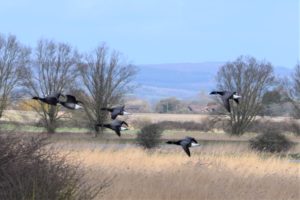
The highlights of the day were a large group of up to 16 Cattle Egrets which were showing well, alongside a healthy population of Grey Herons who were probably breeding in the nearby trees. It would be great if the Egrets follow suit and start breeding there. There were also in the region of 400 or so Black-Tailed Godwits – an impressive sight whenever they took to the air, something in the region of 40-50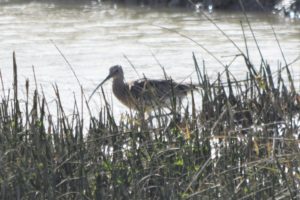 Curlew with their haunting winter calls, and scores of Dark-Bellied Brent Geese flying overhead to the nearby fields when the tide was rising in the harbour.
Curlew with their haunting winter calls, and scores of Dark-Bellied Brent Geese flying overhead to the nearby fields when the tide was rising in the harbour.
All in all, it was a most enjoyable birdwatching visit to a wonderful location which is only about half an hour away from us, and was capped off with a visit to the nearby cafe in Pagham village for lunch before returning home.
Please see below the information handout from Wadars relating to their recent planning application to develop their site to improve the animal wefare facilities there. It clearly outlines the benefits of the scheme and lays to rest the negative comments made by some. Ferring Conservation Group supports the application – the reference number is FG/6/20.
Wadars Rescue and Rehoming Centre, Ferring
Response to concerns raised on the planning portal.
Rewilding As a past livery yard, the property as it stands is almost entirely of concrete and therefore, encourages no natural wildlife beyond vermin and feral cats. We do attract swallows, which continue to nest in our permanent stables. Wadars specialises in the rescue and rehabilitation of wildlife. Our development plans support our work and include creating green spaces throughout the old stable yard, both natural meadow and landscaped, and increasing the number of trees. This is needed both for the improvement of the natural environment and for natural scent and sight barriers between species.
Building design & sustainability The only UPVC structures are those in the further development of the cattery. These are fully insulated units and provide the best possible environment for cats and kittens in a rescue environment. All other construction, including the kennels, are from robust traditional build materials, fully insulated, and include the use of photovoltaic panels for sustainable energy generation. Units are low impact and finished in brickwork and wood fibre cladding, giving a natural, virtually maintenance free finish.
Economic Development Since taking on the property in Hangleton Lane, Wadars has already provided an additional 10 jobs and more than 100 volunteering opportunities. This will increase further as the centre develops. ln additional, we are now providing valuable work experience for students involved in animals welfare and environmental courses at local colleges.
Kennels We have been transparent with our intentions for the property since purchasing in January 2014. When granting ‘change of use’ permission, Arun District Council placed caveats on the positioning and number of kennel units. This has been followed. We are below the capped number of runs and have placed the kennels facing east, at the eastern end of the property, as stipulated by Arun. These kennels are situated at least 100m from any existing residential property.
Barking dogs Dogs in kennels generally only bark when there are people around or they see another animal, they do not bark24/7. Kennels have been designed so that dogs do not face each other; they are separated into three individual blocks so they cannot set each other off. The outdoor exercise runs will be fully fenced with solid fencing so that dogs cannot see dogs in the next run or other animals such as horses. The fence running along the boundary between our kennel area and the neighbouring sand school will also be solid. lt is noted that the livery stables allow client dogs to roam loose and therefore, dogs are already interacting with their horses.
Development There were originally 86 stables on our property. The proposed footprint of the animal rescue and rehoming centre is less that the overall combined footprint of the original stables. The traffic generated by those original 86 stables is more than four times that of our proposed centre.
Staff accommodation The existing flint barn already has lapsed planning permission for conversion to residential. Our plan for the flint barn is purely for staff accommodation to ensure out of hours care for animals in need. The footprint of the barn remains unchanged. There are historic clauses on the property which prevents any owner from selling the barn separately and therefore, it cannot become general housing.
Surface water Considerable investigation has been put into the best drainage systems for surface water across the property. This has included specialist infiltration tests and the development of a drainage plan by specialist engineers, including direction of flood waters to a natural swale. This will also encourage more natural wildlife to the area.
Other centres owned by Wadars Wadars has no other property or centre(s), and never has had. The facility which we use in Lancing is a commercial boarding kennels and costs the charity more than f30,000 in kennelling charges every year
Other benefits
Wadars rehoming centre will allow our specialist animal welfare team to work on any behavioural or socialising needs that dogs and puppies might have before finding new forever homes for them. A dual purpose Training and Education centre will enable us to train and socialise dogs and puppies in our care; we can also invite the local community, especially localyouth groups and other community organi5ations, to learn about responsible pet ownership and wildlife awareness. A purpose built wildlife facility will allow us to expand the work of our Animal Rescue Officers in your community; it will also enable us to reduce stress for more wildlife casualties by caring for them here in Ferring, their natural environment, rather than having to transport them to other centres; journeys that often result in premature and unnecessary deaths of wildlife. Education is a key theme running throughout our proposals and providing placements for local college students studying for roles within the animal care sector is something that we have already begun to do, but which will feature heavily in our plans going forward.
Please note that there will be no work party this coming Tuesday – 3 March.
But please don’t forget the Rife Clean on Saturday 21 March starting at the far end of the Bluebird Cafe cafe cark by the toilets at 11am. Pickers, bags, high vis jackets and gloves are provided, and suggest that you wear wellies as likely to still be wet and muddy. Quite a lot of rubbish has been washed downstream during the floods and is sitting in the vegetation so we hope to see you there to help clear it up.
On a bright, chilly morning 17 members of Ferring Conservation Group met on the beach at the end of Sea Lane in Ferring. The challenge was to identify as many items as possible on the list that Tricia Hall, the Group’s guide for the morning, had provided. With a keen wind behind them the Group set off in an easterly direction carefully exploring the shoreline where there was a good chance that the recent storms had dislodged marine life from the seabed.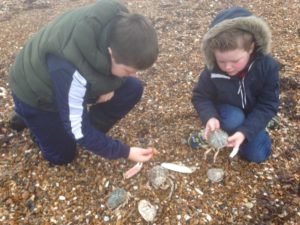
Members were soon surprised at finding many empty shells of large spider crabs, together with pincers and legs. Many of them spied with the keen eyes of two of the youngest participants, Thomas and Eoin Kearns.
Sea lemons (or sea slugs) were found amongst clumps of seaweed; including Sea Oak, Egg Wrack and Irish moss or Carragheen. It was reassuring to see that at least a small amount of Kelp was evident. Jane Hayman from the Group commented that ‘the byelaw to be introduced preventing fishing boats from entering the kelp beds off the Sussex Coast will help save this important marine habitat and hopefully allow the kelp to thrive once more’.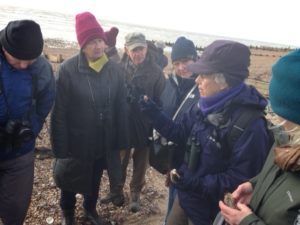
A Sea Squirt, a Starfish and also several kinds of Sponge were identified. Along with the usual egg cases of Sharks, Rays and Cuttlefish, lots of Cuttlefish bones were seen, especially baby ones.
Further along the beach the Group noticed the badly decomposed body of a Thornback Ray, a possible casualty of the recent stormy weather. On hearing the familiar ‘peep-ing’ call of the Oyster Catcher, attention was drawn to the water’s edge where many wading birds including Turnstones and Dunlins were searching for shellfish to eat. An excellent view of these birds was possible with the use of a powerful telescope, kindly provided by member Clive Hall.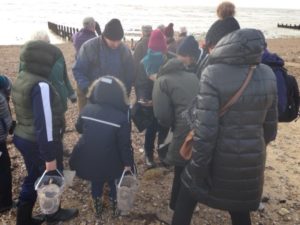
It was reassuring to find that only a small amount of plastic had been washed up but very disappointing to discover many lumps of palm oil. This edible vegetable oil comes from the fruit of oil palm trees and is used in almost 50% of packaged products found in supermarkets and also in animal feed, as well as being used as biofuel in many parts of the world (but not in the UK). It continues to be a major driver of deforestation of some of the world’s most diverse forests. Ships are regularly dumping large quantities of palm oil off the coast of Britain and although it is not poisonous to dogs, if eaten it can cause sickness and in extreme cases, pancreatitis and blockages.
A welcome stop for refreshments at Sea Lane Café gave the Group time to warm up with a hot drink, and before heading back to the starting point Tricia Hall was thanked for her time and the sharing of her considerable knowledge, which made the walk all the more interesting.
At their February meeting, members of Ferring Conservation Group turned out in good numbers to hear an excellent presentation by their own committee member and wildlife expert, Tricia Hall, on a recent organised trip to the wildlife rich country of Costa Rica in Central America.
They learnt that this country makes up just 0.1% of the world’s land mass but is home to 5% of its wildlife species, with many different climates and habitats which support in the region of 500,000 species of plants and animals. Incredibly, Tricia told the audience that there are around 50 species of Hummingbirds in Costa Rica and more butterfly species than in the whole of North America and Africa. Tricia said that the government had a very strong policy on conservation, saving money on defence and paying landowners to plant trees on their land.
The virtual tour of the country took the audience in an anticlockwise circular journey including both the coasts of the Caribbean and the Pacific oceans, as well as a wide variety of inland areas – the highlight of which was probably the volcanoes of the Arenal area in the west of the country. Some of the wildlife highlights illustrated by some brilliant photographs were such creatures as Iguanas, Caymans, Crocodiles, Toucans, Capuchin and Howler monkeys, as well as Sloths and a wide variety of exotic birds. Amazingly, many of these were seen within the grounds of the hotels where the party stayed.
One very amusing story Tricia told was about their coach driver who had to answer a call of nature behind a tree and when looking up he saw what turned out to be an Eyelash Pit Viper just above him. He didn’t stay close for too long!
It was a most enjoyable and entertaining talk, and was followed by a presentation by Julie Toben from local animal welfare organisation, WADARS, on the recent planning application to develop their rescue and re-homing centre in Hangleton Lane, Ferring. She outlined all the relevant points in the application, and carefully debunked a small number of negative comments made by others. At the conclusion, members voted on how the Group should formally respond to the application, and the 70+ members present voted unanimously to support it as an important and welcome addition to local animal welfare facilities.
You may be interested in some upcoming events this year at the National Trust run historic farm at Saddlescombe, near Devil’s Dyke just north of Brighton and Hove as follows:
Farm Open Day on Sunday 28 June from 1030-1530, and a Heritage Open Day on Sunday 20 September also from 1030-1530. These are both free events but there is a £5 car park charge. There is also a cafe, farmers market and guided walks. The farm is situated between Poynings and the Devil’s Dyke road and signposted from the A27. You can also catch the number 77 bus from Brighton railway station and walk there from Devil’s Dyke itself.
There are also 2 Orchid days on Sunday 7 June and Tuesday 16 June from 1030, where there will be a guided walk with a ranger to search for a variety of wild orchids. There is a cost for this and tickets have to be booked via the National Trust website. More details of all the above days can be found there as well.
Tuesday 25 February 10am – guided visit to Warnham Nature Reserve (just off A24 at Horsham). Excellent place to view birds at close quarters from the various hides. This is a “get yourselves there” visit but lifts can be arranged. Small admission fee of £2 and light refreshments are available there.
Thursday 12 March 10am – guided birdwatching visit to Pagham Harbour (North Wall) with Clive Hope. One of the best sites locally for wading birds and others. Park on Church Lane (far end) nr Pagham village on east side of the harbour. Another “get yourselves there” visit but again lifts can be arranged. You can stay for lunch in café at Pagham if you wish.
Plus, don’t forget Rife Clean on Sat 21 March 11am
For the first meeting of 2020 Ferring Conservation Group, with a near record attendance, welcomed back Lee Morgan from Lutra Wildlife, a British Columbia based travel and Ecotourism Company offering guided natural history and wildlife holidays. On Lee’s second visit to the Group he gave a fascinating presentation entitled ‘The Natural History of the Canadian Rockies (Beyond the Roads and Rails).
Lee explained that to optimize your chances of spotting the iconic wildlife of the Canadian Rocky Mountains a lot has to do with luck and being in the right place at the right time given the vastness of the area. There are certain places where animals are known to frequent, but part of the magic is that you never know when you are going to see something. Many tourists to the region make the mistake of trying to cover a large area to see as much as possible not realising that this would entail hour upon hour of driving with little time to take in the spectacular scenery, let alone get close to any wildlife. Lee advised the audience that the best time of the year to witness wildlife in their natural habitat is during the slower tourist seasons of spring, autumn and winter. This is when many of the animals move to lower elevations and near towns for mating rituals and food. As an example he informed the audience that during the elk rutting season from mid-September through October the bulls concentrate in the lower elevation meadows to fight over females. The bulls are extremely aggressive at this time so it is advisable to keep your distance.
Autumn is also the time when bears are actively foraging as they need to put on as much fat as possible before going into hibernation. Bighorn sheep are visible all year round but autumn and winter are the best times to spot the males as they are actively searching for mates.
In the spring as the snow begins to thaw in the lower valleys, the wildlife can be seen foraging for grass along the road sides. You may see female elk grouped together in meadows with their new calves. Bighorn sheep and deer start to bring their young to the grassy areas as well. The odd bear can sometimes be seen as early as mid-March but most will start to come out of hibernation in late April.
As summer approaches the temperatures rise and this causes wildlife to head higher up the alpine terrain. Lee commented that, surprisingly, the lesser visited Jasper, Yoho and Kootenay National parks can offer some of the best opportunities to see wildlife. These parks have a lower level of tourist traffic and a more varied habitat than the area of Banff.
Lee illustrated his presentation with a series of stunning photographs.
Ed Miller took to the floor to give an update on planning issues by advising the Group that the application for an additional property in the grounds of Elm Lodge, Tamarisk Way had been refused by Arun DC. There are two new applications: at 40, Little Paddocks to demolish the existing property and build 2 x 3 bed detached chalet bungalows and a 3 bed residence has been proposed at the Equestrian centre alongside Littlehampton Road. The office block at McIntyre’s Lane and the extended delivery times at Quercus Nursery have not yet been decided.
Tricia Hall concluded the meeting with her popular Nature Notes saying that it had been reported on the television news that a byelaw is to be introduced to prevent trawlers from entering the kelp bed areas along the Sussex coast .This will hopefully result in these vitally important regions recovering over time. Tricia also reported that the National Big Bird Watch revealed that sparrows were the most plentiful bird seen followed by bluetits in second place.